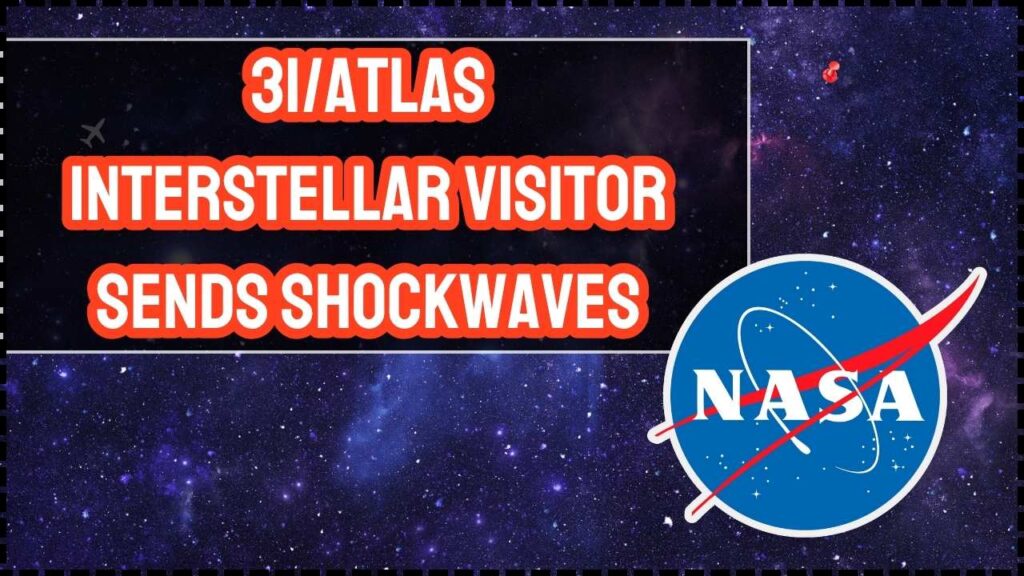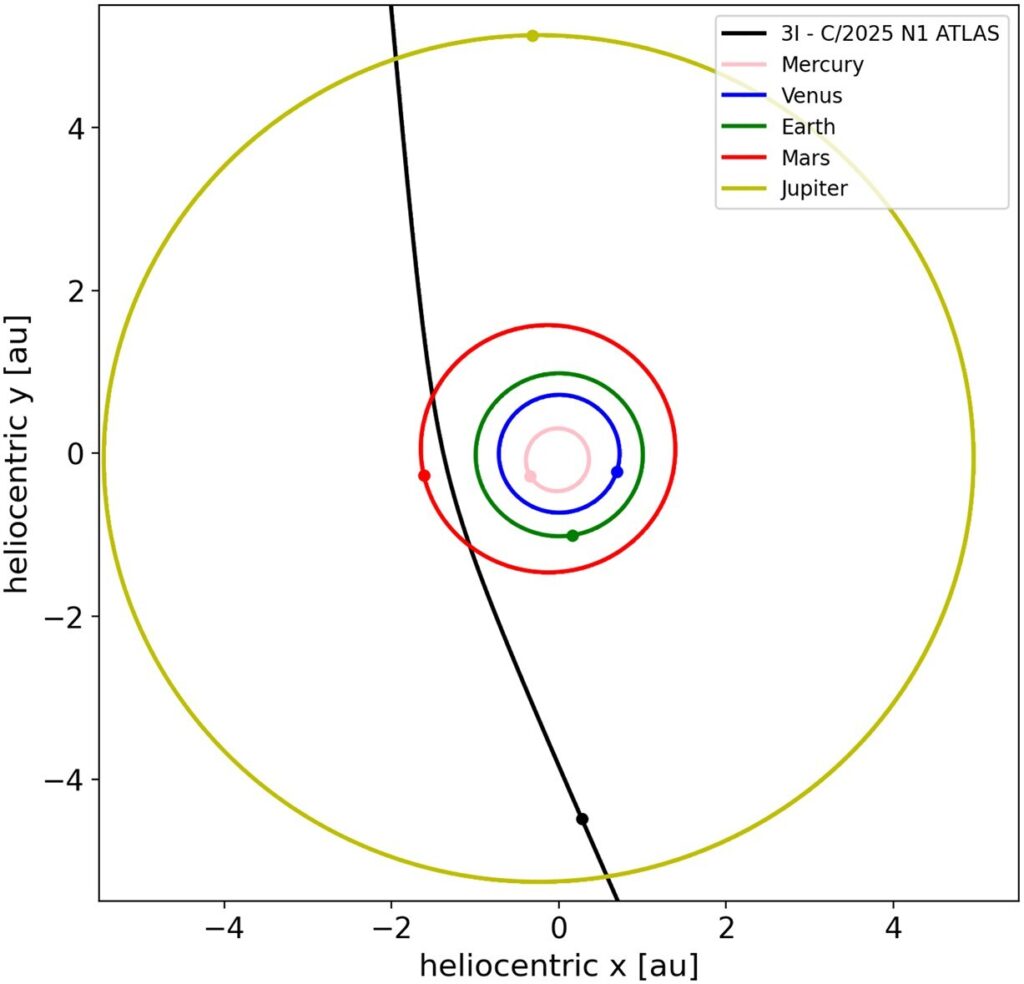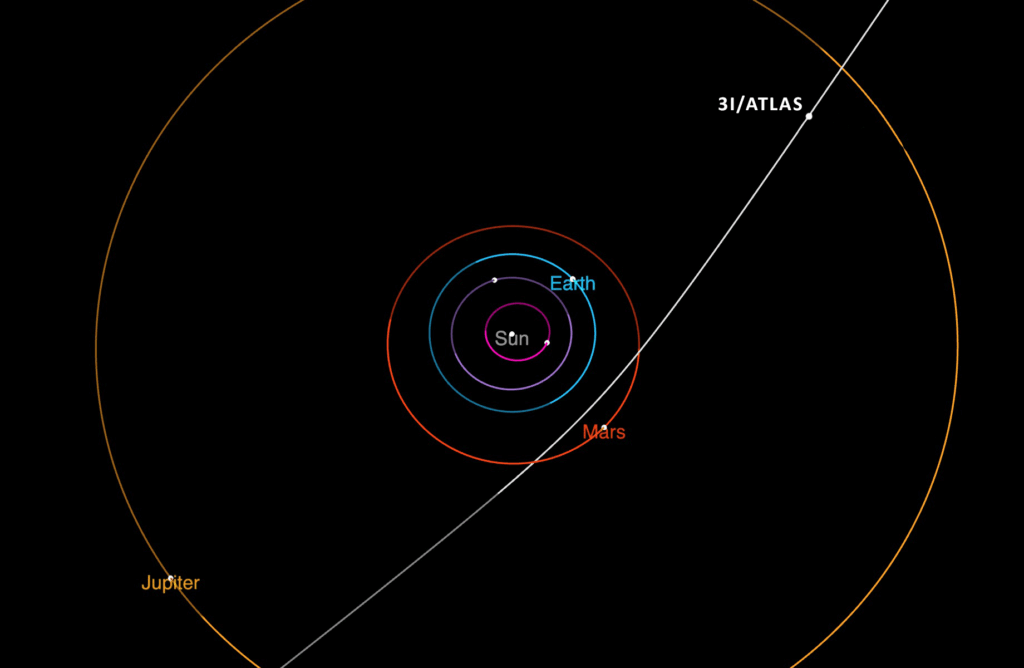3I/ATLAS Interstellar Visitor Sends Shockwaves: When NASA says it’s keeping a close watch on something streaking across the sky, people listen. The latest celestial guest making headlines is 3I/ATLAS, an interstellar comet that recently entered our Solar System. This mysterious traveler isn’t just another space rock; it’s an object that comes from beyond our Sun’s gravitational pull — a messenger from another star system. Before we go any further, let’s clear one thing up — no, it’s not a threat to Earth. NASA has confirmed that 3I/ATLAS will pass at a safe distance, far beyond our Moon’s orbit. But what makes this visitor so special is the story it carries. This comet isn’t from our neighborhood; it’s from the far reaches of the galaxy, offering us a once-in-a-generation opportunity to learn about the wider universe.
Table of Contents
3I/ATLAS Interstellar Visitor Sends Shockwaves
The arrival of 3I/ATLAS reminds us that our Solar System is part of a much larger galactic community. It’s not just an astronomical event — it’s a story of curiosity, collaboration, and discovery. From NASA scientists tracking its every move to schoolchildren learning about it in classrooms, this interstellar comet connects us all in our shared fascination with the stars. So, while NASA is “on alert,” it’s not out of fear — it’s out of wonder. 3I/ATLAS is a traveler from the deep unknown, offering us a brief glimpse into the mysteries of the universe before it sails away forever.

| Feature | Details |
|---|---|
| Object Name | 3I/ATLAS |
| Type | Interstellar Comet |
| Discovery Date | July 1, 2025 |
| Discovered By | ATLAS Survey, Hawaii |
| Speed | ~221,000 km/h (61 km/s) |
| Size Estimate | 0.4 – 5.6 km in diameter |
| Closest Approach to Earth | 1.8 AU (~270 million km) |
| Closest to Sun (Perihelion) | October 30, 2025 |
| Orbit Type | Hyperbolic — unbound from the Sun |
| Official NASA Page | NASA: 3I/ATLAS Overview |
What Exactly Is 3I/ATLAS?
3I/ATLAS stands for the third interstellar object ever discovered. It was first detected on July 1, 2025, by the Asteroid Terrestrial-impact Last Alert System (ATLAS) in Hawaii — a network of telescopes designed to spot potentially hazardous asteroids. When astronomers noticed its unusual speed and trajectory, they knew they had stumbled upon something extraordinary.
NASA scientists quickly determined that 3I/ATLAS wasn’t bound by the Sun’s gravity. Instead, it’s flying through our Solar System on a hyperbolic orbit, meaning it entered from interstellar space and will eventually exit again, never to return. That’s a pretty big deal — it’s only the third time in recorded history we’ve been able to study an object from another solar system passing through ours.
According to NASA’s official report, the comet is moving at an incredible 221,000 kilometers per hour (around 137,000 miles per hour). To put that in perspective, if it were heading toward Earth, it could circle the entire planet in less than 10 minutes. Thankfully, it’s not coming anywhere near us. Its closest approach to Earth will be about 1.8 astronomical units, or roughly 270 million kilometers away.

Why NASA Is on “Alert”?
The phrase “NASA on alert” might sound dramatic, but it doesn’t mean panic. It simply means NASA is paying very close attention. When an object this rare appears, the scientific community mobilizes quickly to observe, record, and analyze as much data as possible before it vanishes into the dark again.
NASA’s Hubble Space Telescope, the James Webb Space Telescope (JWST), and observatories around the world are all collecting information on 3I/ATLAS. Researchers want to know what it’s made of, how it formed, and where it came from. Studying an interstellar object like this allows scientists to compare it to comets in our own Solar System — and that can tell us whether other star systems have the same ingredients for life.
In the words of Dr. Thomas Zurbuchen, a former NASA Science Associate Administrator, “Each interstellar object is a time capsule. It carries the chemical fingerprints of a world we may never see again.”
A Quick History of Interstellar Visitors
Before 2017, no one had ever confirmed an object entering our Solar System from interstellar space. Then came a few unexpected guests that changed astronomy forever.
- 1I/ʻOumuamua (2017) – The first confirmed interstellar object. Its elongated shape and strange motion made headlines, with some even speculating it might be artificial. It wasn’t, but it sparked intense debate.
- 2I/Borisov (2019) – A comet discovered by amateur astronomer Gennady Borisov. It had a visible tail and behaved like comets from our own Solar System, giving scientists the first clear look at an interstellar comet.
- 3I/ATLAS (2025) – The newest and most studied of the three. It’s larger, faster, and displays a strong gas coma (a glowing cloud around the nucleus), indicating it’s rich in ices and volatile gases.
With only three confirmed interstellar visitors so far, every observation is a precious scientific opportunity.
What Makes 3I/ATLAS Unique?
First off, 3I/ATLAS is believed to be larger and brighter than its predecessors. Early data suggests the nucleus — the solid core of the comet — could be anywhere between 0.4 and 5.6 kilometers wide. That might not sound huge, but in astronomical terms, it’s big enough to reflect sunlight strongly and produce a spectacular tail of gas and dust.
Spectroscopic data (which analyzes the light emitted by the comet) indicates a high level of carbon dioxide and water ice, hinting that it formed in an extremely cold region — likely at the edge of its home solar system. That’s a major clue about the conditions around other stars.
Astronomers also believe its speed and trajectory could tell us something about its origin. By tracing its path backward, researchers estimate it entered our Solar System from the direction of the constellation Lynx, though it’s impossible to pinpoint the exact star system it came from. It may have spent millions, even billions, of years drifting through the Milky Way before arriving here.

How Scientists Study 3I/ATLAS Interstellar Visitor Sends Shockwaves?
Catching an interstellar comet is no easy task. Because it’s moving so fast and will only be visible for a few months, astronomers worldwide are coordinating like never before. NASA’s Planetary Defense Coordination Office has categorized 3I/ATLAS as a “non-hazard interstellar object” and prioritized it for continuous observation.
Data is being shared through the Planetary Data System (PDS), an open-access database that allows scientists and even students to analyze real-time information. Ground-based observatories in Chile, Spain, and Arizona are measuring how the comet’s brightness changes as it approaches the Sun. This helps estimate its rotation speed and activity level — whether it’s shedding gas evenly or in bursts.
Meanwhile, NASA’s James Webb Space Telescope is using its infrared sensors to detect the chemical composition of the gases being released. By comparing these readings to known Solar System comets, scientists can figure out how “alien” 3I/ATLAS truly is.
What “Hyperbolic Orbit” Means in Simple Terms?
Most comets in our Solar System follow elliptical orbits, which means they loop around the Sun repeatedly, like Halley’s Comet that appears every 76 years.
A hyperbolic orbit, on the other hand, is open-ended — once the object leaves, it’s gone forever.
3I/ATLAS’s hyperbolic trajectory proves it’s not gravitationally bound to our Sun. It entered our Solar System from interstellar space and will exit again, likely heading toward another star system. Scientists calculate that it will cross Neptune’s orbit by early 2026 and disappear into the darkness for good.
The Broader Significance
Objects like 3I/ATLAS remind us that the universe is constantly moving and interconnected. They also highlight how far technology has come. A few decades ago, detecting an object this distant would have been impossible. Now, thanks to automated surveys, artificial intelligence, and global telescope networks, astronomers can identify interstellar objects within days.
These discoveries also inspire the next generation of scientists. Many schools and astronomy clubs in the U.S. are organizing “Comet Nights” this fall to teach kids about orbital mechanics, telescope use, and planetary defense. Educational platforms like NASA’s Eyes on the Solar System even let users simulate 3I/ATLAS’s journey in 3D.
How to Observe 3I/ATLAS Interstellar Visitor Sends Shockwaves?
While you won’t be able to see it with the naked eye, amateur astronomers using small telescopes might catch a glimpse as it brightens near its closest point to the Sun in late October 2025. If you use apps like SkySafari or Stellarium, just type “3I/ATLAS,” and you’ll see its real-time position.
Those living in rural areas or under dark skies will have the best chance to photograph it. Astrophotographers are already preparing long-exposure shots, hoping to capture the greenish glow typical of comets rich in carbon gases.
SpaceX Starship Megarocket Hits Key Milestones Before Stunning Splashdown
Expert Perspectives
Dr. Karen Meech of the University of Hawaii, who also helped study 1I/ʻOumuamua, said, “This is a cosmic gift. 3I/ATLAS is a sample of material from another solar system, arriving right at our doorstep.”
Dr. Amy Mainzer of NASA’s Jet Propulsion Laboratory added, “It’s like finding a message in a bottle floating through the ocean of the galaxy. Every molecule we detect tells a story about how stars and planets are born elsewhere.”
Their comments highlight just how thrilling this discovery is for the global scientific community.
What This Means for Future Science?
The discovery of 3I/ATLAS is not just about one comet — it’s part of a bigger story. As telescopes get better, we’ll likely find more interstellar visitors in the coming years. Each one helps refine our understanding of planetary formation and the chemical ingredients necessary for life.
NASA is already planning future missions that could intercept such objects. Concepts like the “Comet Interceptor” mission, planned by the European Space Agency, could one day fly close to a newly discovered interstellar object to collect samples or images.















